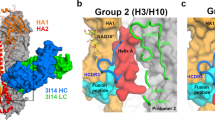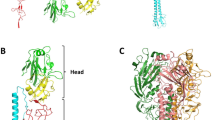Abstract
Despite diligent vaccination efforts, influenza virus infection remains a major cause for respiratory-related illness across the globe. The less-than-optimal immunity conferred by the currently prescribed seasonal vaccines and protracted production times warrant the development of novel vaccines. Induction of an epitope-focused antibody response targeting known neutralization epitopes is a viable strategy to enhance the breadth of protection against rapidly evolving infectious viruses. We report the development of a design framework to mimic the hemagglutinin (HA) head fragment of H1-subtype viruses by delineating the interaction network of invariant residues lining the receptor binding site (RBS); a site targeted by cross-reactive neutralizing antibodies. The incorporation of multiple sequence alignment information in our algorithm to fix the construct termini and engineer rational mutations facilitates the facile extension of the design to heterologous (subtype-specific) influenza strains. We evaluated our design protocol by generating head fragments from divergent influenza A H1N1 A/Puerto Rico/8/34 and pH1N1 A/California/07/2009 strains that share a sequence identity of only 74.4% within the HA1 subunit. The designed immunogens exhibited characteristics of a well-ordered protein, and bound conformation-specific RBS targeting antibodies with high affinity, a desirable feature for putative vaccine candidates. Additionally, the bacterial expression of these immunogens provides a low-cost, rapidly scalable alternative.








Similar content being viewed by others
References
Krammer F, Palese P (2015) Advances in the development of influenza virus vaccines. Nat Rev Drug Discov 14(3):167–182
Kumar A, Singh S (2015) Editorial: influenza virus vaccines and immunotherapies. Front Immunol 6:599
Schultz-Cherry S, Jones JC (2010) Influenza vaccines: the good, the bad, and the eggs. Adv Virus Res 77:63–84
Carrat F, Flahault A (2007) Influenza vaccine: the challenge of antigenic drift. Vaccine 25(39–40):6852–6862
Flannery B et al (2015) Early estimates of seasonal influenza vaccine effectiveness–United States, January 2015. MMWR Morb Mortal Wkly Rep 64(1):10–15
Gerhard W (2001) The role of the antibody response in influenza virus infection. Curr Top Microbiol Immunol 260:171–190
Shi Y et al (2014) Enabling the “host jump”: structural determinants of receptor-binding specificity in influenza A viruses. Nat Rev Microbiol 12(12):822–831
Skehel JJ, Wiley DC (2000) Receptor binding and membrane fusion in virus entry: the influenza hemagglutinin. Annu Rev Biochem 69:531–569
Xiong X, McCauley JW, Steinhauer DA (2014) Receptor binding properties of the influenza virus hemagglutinin as a determinant of host range. Curr Top Microbiol Immunol 385:63–91
Carr CM, Kim PS (1993) A spring-loaded mechanism for the conformational change of influenza hemagglutinin. Cell 73(4):823–832
Braakman I et al (1991) Folding of influenza hemagglutinin in the endoplasmic reticulum. J Cell Biol 114(3):401–411
Caton AJ et al (1982) The antigenic structure of the influenza virus A/PR/8/34 hemagglutinin (H1 subtype). Cell 31(2 Pt 1):417–427
Wiley DC, Wilson IA, Skehel JJ (1981) Structural identification of the antibody-binding sites of Hong Kong influenza haemagglutinin and their involvement in antigenic variation. Nature 289(5796):373–378
Neumann G, Kawaoka Y (2015) Transmission of influenza A viruses. Virology 479–480:234–246
Laursen NS, Wilson IA (2013) Broadly neutralizing antibodies against influenza viruses. Antiviral Res 98(3):476–483
Rathore U et al (2014) Immunogen design for HIV-1 and influenza. Biochim Biophys Acta 1844(11):1891–1906
Dreyfus C et al (2012) Highly conserved protective epitopes on influenza B viruses. Science 337(6100):1343–1348
Ekiert DC et al (2012) Cross-neutralization of influenza A viruses mediated by a single antibody loop. Nature 489(7417):526–532
Wine Y et al (2015) Serology in the 21st century: the molecular-level analysis of the serum antibody repertoire. Curr Opin Immunol 35:89–97
Corti D, Lanzavecchia A (2013) Broadly neutralizing antiviral antibodies. Annu Rev Immunol 31:705–742
Van, T.D., et al., A Perspective on Rational Designs of a Hemagglutinin Based Universal Influenza Vaccine. Curr Pharm Des, 2016.
Ellebedy AH, Ahmed R (2012) Re-engaging cross-reactive memory B cells: the influenza puzzle. Front Immunol 3:53
Andreatta RH, Liem RK, Scheraga HA (1971) Mechanism of action of thrombin on fibrinogen. I. Synthesis of fibrinogen-like peptides, and their proteolysis by thrombin and trypsin. Proc Natl Acad Sci U S A 68(2):253–256
Anfinsen CB, Scheraga HA (1975) Experimental and theoretical aspects of protein folding. Adv Protein Chem 29:205–300
Dyson HJ, Wright PE, Scheraga HA (2006) The role of hydrophobic interactions in initiation and propagation of protein folding. Proc Natl Acad Sci U S A 103(35):13057–13061
Huang Y et al (2010) CD-HIT Suite: a web server for clustering and comparing biological sequences. Bioinformatics 26(5):680–682
Higgins DG, Sharp PM (1988) CLUSTAL: a package for performing multiple sequence alignment on a microcomputer. Gene 73(1):237–244
Gamblin SJ et al (2004) The structure and receptor binding properties of the 1918 influenza hemagglutinin. Science 303(5665):1838–1842
Ganesh C et al (1997) Thermodynamic characterization of the reversible, two-state unfolding of maltose binding protein, a large two-domain protein. Biochemistry 36(16):5020–5028
Ellman GL (1959) Tissue sulfhydryl groups. Arch Biochem Biophys 82(1):70–77
Riddles PW, Blakeley RL, Zerner B (1979) Ellman’s reagent: 5,5’-dithiobis(2-nitrobenzoic acid)–a reexamination. Anal Biochem 94(1):75–81
Russell RJ et al (2006) Avian and human receptor binding by hemagglutinins of influenza A viruses. Glycoconj J 23(1–2):85–92
Stencel-Baerenwald JE et al (2014) The sweet spot: defining virus-sialic acid interactions. Nat Rev Microbiol 12(11):739–749
Lutteke T, Frank M, von der Lieth CW (2005) Carbohydrate Structure Suite (CSS): analysis of carbohydrate 3D structures derived from the PDB. Nucleic Acids Res 33:D242–D246
Sabesan S, Bock K, Paulson JC (1991) Conformational analysis of sialyloligosaccharides. Carbohydr Res 218:27–54
Hong M et al (2013) Antibody recognition of the pandemic H1N1 Influenza virus hemagglutinin receptor binding site. J Virol 87(22):12471–12480
Whittle JR et al (2011) Broadly neutralizing human antibody that recognizes the receptor-binding pocket of influenza virus hemagglutinin. Proc Natl Acad Sci U S A 108(34):14216–14221
Sharma D et al (2005) Protein minimization of the gp120 binding region of human CD4. Biochemistry 44(49):16192–16202
Li LK, Riehm JP, Scheraga HA (1966) Structural studies of ribonuclease 23 Pairing of the tyrosyl and carboxyl groups. Biochemistry 5(6):2043–2048
Kuhlman B et al (2003) Design of a novel globular protein fold with atomic-level accuracy. Science 302(5649):1364–1368
Mallajosyula VV et al (2014) Influenza hemagglutinin stem-fragment immunogen elicits broadly neutralizing antibodies and confers heterologous protection. Proc Natl Acad Sci U S A 111(25):E2514–E2523
Mallajosyula VV et al (2015) Hemagglutinin Sequence Conservation Guided Stem Immunogen Design from Influenza A H3 Subtype. Front Immunol 6:329
Mallajosyula VV et al (2013) In vitro and in vivo characterization of designed immunogens derived from the CD-helix of the stem of influenza hemagglutinin. Proteins 81(10):1759–1775
Valkenburg SA et al (2016) Stalking influenza by vaccination with pre-fusion headless HA mini-stem. Sci Rep 6:22666
Jia B, Jeon CO (2016) High-throughput recombinant protein expression in Escherichia coli: current status and future perspectives. Open Biol 6(8):160196
Aguilar-Yanez JM et al (2010) An influenza A/H1N1/2009 hemagglutinin vaccine produced in Escherichia coli. PLoS ONE 5(7):e11694
Song L et al (2008) Efficacious recombinant influenza vaccines produced by high yield bacterial expression: a solution to global pandemic and seasonal needs. PLoS ONE 3(5):e2257
Xu R et al (2012) Structural characterization of the hemagglutinin receptor specificity from the 2009 H1N1 influenza pandemic. J Virol 86(2):982–990
Hao MH, Scheraga HA (1998) Molecular mechanisms for cooperative folding of proteins. J Mol Biol 277(4):973–983
Gahl RF, Scheraga HA (2009) Oxidative folding pathway of onconase, a ribonuclease homologue: insight into oxidative folding mechanisms from a study of two homologues. Biochemistry 48(12):2740–2751
Houry WA, Rothwarf DM, Scheraga HA (1994) A very fast phase in the refolding of disulfide-intact ribonuclease A: implications for the refolding and unfolding pathways. Biochemistry 33(9):2516–2530
Kavaler J et al (1990) A set of closely related antibodies dominates the primary antibody response to the antigenic site CB of the A/PR/8/34 influenza virus hemagglutinin. J Immunol 145(7):2312–2321
Staudt LM, Gerhard W (1983) Generation of antibody diversity in the immune response of BALB/c mice to influenza virus hemagglutinin I Significant variation in repertoire expression between individual mice. J Exp Med 157(2):687–704
Yewdell JW, Caton AJ, Gerhard W (1986) Selection of influenza A virus adsorptive mutants by growth in the presence of a mixture of monoclonal antihemagglutinin antibodies. J Virol 57(2):623–628
Ambroggio XI et al (2013) HASP server: a database and structural visualization platform for comparative models of influenza A hemagglutinin proteins. BMC Bioinformatics 14:197
Kim R, Guo JT (2010) Systematic analysis of short internal indels and their impact on protein folding. BMC Struct Biol 10:24
Shembekar N et al (2013) Isolation of a high affinity neutralizing monoclonal antibody against 2009 pandemic H1N1 virus that binds at the “Sa” antigenic site. PLoS ONE 8(1):e55516
Xu R et al (2010) Structural basis of preexisting immunity to the 2009 H1N1 pandemic influenza virus. Science 328(5976):357–360
Khurana S et al (2011) Recombinant HA1 produced in E coli forms functional oligomers and generates strain-specific SRID potency antibodies for pandemic influenza vaccines. Vaccine 29(34):5657–5665
Magadan JG et al (2013) Influenza A virus hemagglutinin trimerization completes monomer folding and antigenicity. J Virol 87(17):9742–9753
Bagchi B (2016) Untangling complex dynamics of biological water at protein-water interface. Proc Natl Acad Sci U S A 113(30):8355–8357
Wertz DH, Scheraga HA (1978) Influence of water on protein structur An analysis of the preferences of amino acid residues for the inside or outside and for specific conformations in a protein molecule. Macromolecules 11(1):9–15
Bhattacharyya S et al (2013) Design of an Escherichia coli expressed HIV-1 gp120 fragment immunogen that binds to b12 and induces broad and potent neutralizing antibodies. J Biol Chem 288(14):9815–9825
Impagliazzo A et al (2015) A stable trimeric influenza hemagglutinin stem as a broadly protective immunogen. Science 349(6254):1301–1306
Jardine J et al (2013) Rational HIV immunogen design to target specific germline B cell receptors. Science 340(6133):711–716
Joyce MG et al (2016) Iterative structure-based improvement of a fusion-glycoprotein vaccine against RSV. Nat Struct Mol Biol 23(9):811–820
Kanekiyo M et al (2015) Rational Design of an Epstein-Barr Virus Vaccine Targeting the Receptor-Binding Site. Cell 162(5):1090–1100
Yassine HM et al (2015) Hemagglutinin-stem nanoparticles generate heterosubtypic influenza protection. Nat Med 21(9):1065–1070
Jegerlehner A et al (2013) Bacterially produced recombinant influenza vaccines based on virus-like particles. PLoS ONE 8(11):e78947
Acknowledgements
We thank Dr. James Crowe for providing the 2D1 antibody. The anti-H1N1 A/Puerto Rico/8/34 virus convalescent sera was provided by Dr. Jessica Flynn (Merck Research Laboratories, PA, USA). Dr. Satish Kumar Gupta provided the anti-pH1N1 A/California/07/2009 virus convalescent sera and MA-2077 antibody.
Funding
VVAM acknowledges the fellowship received from the Council of Scientific and Industrial Research, Government of India (GOI). SS is recipient of research associate fellowship from Department of Biotechnology (DBT), GOI. This work was supported in part by a grant from the DBT, GOI to RV.
Author information
Authors and Affiliations
Contributions
All authors contributed to the study conception and design. Experiments and analysis were performed by V VAM and SS under the supervision of RV. All authors read and approved the final manuscript.
Corresponding author
Ethics declarations
Conflict of interest
The authors declare no conflict of interest.
Additional information
Publisher's Note
Springer Nature remains neutral with regard to jurisdictional claims in published maps and institutional affiliations.
Electronic supplementary material
Below is the link to the electronic supplementary material.
Rights and permissions
About this article
Cite this article
Mallajosyula, V.A., Swaroop, S. & Varadarajan, R. Influenza Hemagglutinin Head Domain Mimicry by Rational Design. Protein J 39, 434–448 (2020). https://doi.org/10.1007/s10930-020-09930-z
Accepted:
Published:
Issue Date:
DOI: https://doi.org/10.1007/s10930-020-09930-z




